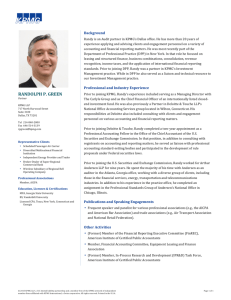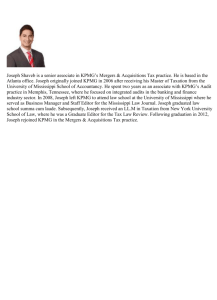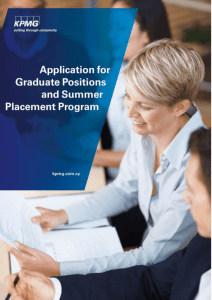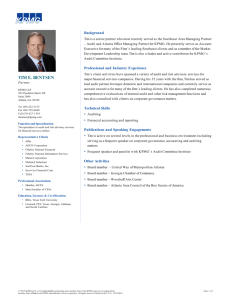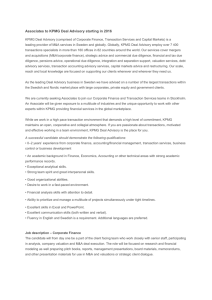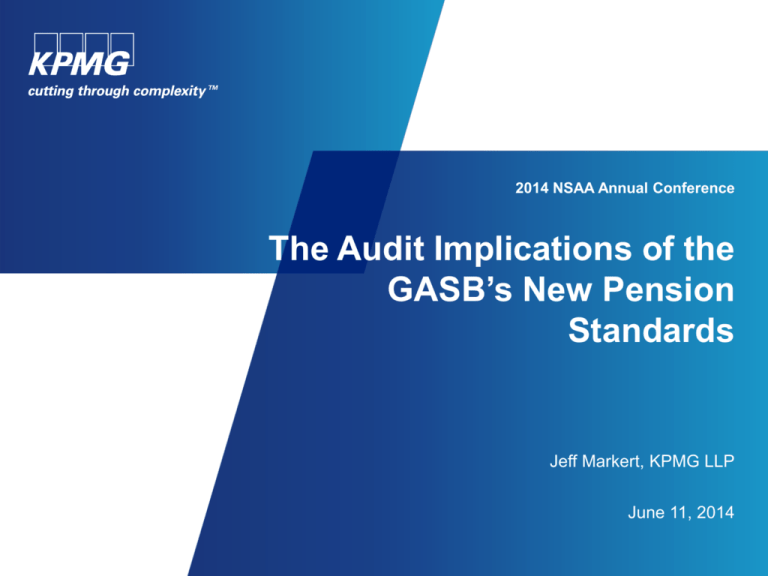
2014 NSAA Annual Conference
The Audit Implications of the
GASB’s New Pension
Standards
Jeff Markert, KPMG LLP
June 11, 2014
Speaker Biography
Jeff Markert, CPA, is a partner with KPMG LLP (KPMG) with more than 24
years of experience serving not-for-profit and state and local organizations. In
April of 2010, Jeff transferred to KPMG’s Department of Professional Practice
in New York City. In this role, he devotes significant time to emerging issues
related to government organizations, including providing technical assistance
and training to KPMG personnel throughout the United States. Jeff is
currently the Chair of the AICPA State and Local Government Expert Panel and
is also the chair of their task force on pension accounting and audit issues.
Prior to joining KPMG’s Department of Professional Practice, Jeff spent 20
years in KPMG’s Chicago office and was the practice leader for KPMG’s
Midwest public sector audit group. In this role, Jeff was responsible for notfor-profit and government services and also served as the engagement
partner for many of their larger and more complex clients.
© 2014 KPMG LLP, a Delaware limited liability partnership and the U.S. member firm of the KPMG network of independent member firms affiliated with KPMG
International Cooperative (“KPMG International”), a Swiss entity. All rights reserved.
American Institute of CPAs
2
Agenda
Issues Related to Cost-Sharing
Multiple-Employer Plans
Issues Related to Agent MultipleEmployer Plans
Common Questions/ Issues
Next Steps
© 2014 KPMG LLP, a Delaware limited liability partnership and the U.S. member firm of the KPMG network of independent member firms affiliated with KPMG
International Cooperative (“KPMG International”), a Swiss entity. All rights reserved.
American Institute of CPAs
3
Issues Related to CostSharing MultipleEmployer Plans
4
Cost-Sharing Plan Issues
Audited
financial statements of the plan only include disclosure
of the collective net pension liability for the plan as a whole.
They do NOT include:
•
•
•
Deferred outflows/inflows of resources by category
Pension expense
Each participating employer’s share of collective pension amounts
Standard
is silent on who (plan or each individual participating
employer) should calculate allocation percentages
Audited financial statements of the plan may not include
necessary information to calculate allocation percentages
Standard provides flexibility in approach to determining
allocations
Standard encourages an allocation method would be extremely
difficult to audit as it is based on projected future contributions
© 2014 KPMG LLP, a Delaware limited liability partnership and the U.S. member firm of the KPMG network of independent member firms affiliated with KPMG
International Cooperative (“KPMG International”), a Swiss entity. All rights reserved.
American Institute of CPAs
5
Cost-Sharing Plan Issues
GAAP
financial statements of the plan and additional
unaudited information from the plan will NOT provide
sufficient appropriate audit evidence for the governmental
employer auditor.
– Absent
additional audit evidence from the cost-sharing plan,
the employer auditor would not likely be able to accumulate
sufficient appropriate audit evidence.
– If unable to accumulate sufficient appropriate evidence, the
employer auditor should modify the audit opinion.
(AU-C section 9500, Question 2)
© 2014 KPMG LLP, a Delaware limited liability partnership and the U.S. member firm of the KPMG network of independent member firms affiliated with KPMG
International Cooperative (“KPMG International”), a Swiss entity. All rights reserved.
American Institute of CPAs
6
Cost-Sharing Plans—Current Status of AICPA
Recommendations
Whitepapers
Government
Employer Participation in Cost-Sharing Multiple
Employer Plans: Issues Related to Information for Employer
Reporting
Single-Employer and Cost-Sharing Multiple-Employer Plans:
Issues Associated with Testing Census Data
Auditing Interpretations
Issued
interpretations to 3 AU-C sections
– AU-C 500
– AU-C 600
– AU-C 805
© 2014 KPMG LLP, a Delaware limited liability partnership and the U.S. member firm of the KPMG network of independent member firms affiliated with KPMG
International Cooperative (“KPMG International”), a Swiss entity. All rights reserved.
American Institute of CPAs
Links to Papers &
Interpretations on
GAQC “GASB Matters”
website:
www.aicpa.org/GAQC
7
Cost-Sharing Plans—AICPA Recommendations
Plan
prepares “schedule of employer allocations” for which
plan auditor is engaged to provide opinion
Plan prepares “schedule of pension amounts by employer”
for which plan auditor engaged to provide opinion
– Plan
auditor needs to consider the appropriateness of the
materiality used in the audit of plan financial statements
For
audit of a public employee retirement system (PERS) plan
financial statements, the audit opinion is provided on the system as
a whole (which often includes more than one plan)
Audit of plan financial statements effectively has to be performed at
a lower level consistent with the “allocation” pool
© 2014 KPMG LLP, a Delaware limited liability partnership and the U.S. member firm of the KPMG network of independent member firms affiliated with KPMG
International Cooperative (“KPMG International”), a Swiss entity. All rights reserved.
American Institute of CPAs
8
Example Schedule of Employer Allocations
EXAMPLE COST SHARING PENSION PLAN
Schedule of Employer Allocations
6/30/20X5
20X5
Actual
Employer
Contributions
Employer
Employer 1
Employer 2
Employer 3
$
2,143,842
268,425
322,142
Employer
Allocation
Percentage
36.376 %
4.554
5.466
Employer 4
Employer 5
Employer 6
Employer 7
Employer 8
Employer 9
483,255
633,125
144,288
95,365
94,238
795,365
8.199
10.742
2.448
1.618
1.599
13.495
Employer 10
Employer 11
Employer 12
Employer 13
Employer 14
267,468
403,527
165,886
68,454
6,240
4.538
6.847
2.815
1.161
0.106
Employer 15
2,144
0.036
Total
© 2014 KPMG LLP, a Delaware limited liability partnership and the U.S. member firm of the KPMG network of independent member firms affiliated with KPMG
International Cooperative (“KPMG International”), a Swiss entity. All rights reserved.
American Institute of CPAs
$
5,893,764
100.000 %
9
Example Schedule of Pension Amounts by
Employer
EX A M P LE C OS T S HA R IN G P EN S ION P LA N
Sched ule o f Pens io n Amo unts b y Emp lo yer
As o f and fo r the year end ed 6 /3 0 /2 0 X5
D e f e rre d Out f lo w s o f R e s o urc e s
D e f e rre d Inf lo w s o f R e s o urc e s
P e ns io n Ex p e ns e
N e t A mo rt iz a t io n
o f D e f e rre d
A mo unt s f ro m
D if f e re nc e s
Ent it y
C ha ng e s in
C ha ng e s in
N e t D if f e re nc e
P ro p o rt io n
P ro p o rt io n
P ro p o rt io n
B etween
a nd D if f e re nc e s
a nd D if f e re nc e s
a nd D if f e re nc e s
P ro je c t e d
B etween
a nd A c t ua l
Emp lo y e r
To t a l
C ha ng e s in
B etween
D if f e re nc e s
B etween
Emp lo y e r
To t a l
P ro p o rt io na t e
Emp lo y e r
B etween
Inv e s t me nt
C o nt rib ut io ns
D e f e rre d
B etween
C o nt rib ut io ns
D e f e rre d
S ha re o f
Ex p e c t e d
Ea rning s o n
a nd P ro p o rt io na t e
Out f lo w s
Ex p e c t e d
a nd P ro p o rt io na t e
Inf lo w s
P la n
C o nt rib ut io ns
To t a l
N e t P e ns io n
a nd A c t ua l
P e ns io n P la n
C ha ng e s o f
S ha re o f
of
a nd A c t ua l
C ha ng e s o f
S ha re o f
of
P e ns io n
S ha re o f
P e ns io n
Lia b ilit y
Ex p e rie nc e
Inv e s t me nt s
A s s ump t io ns
C o nt rib ut io ns
R e s o urc e s
Ex p e rie nc e
A s s ump t io ns
C o nt rib ut io ns
R e s o urc e s
Ex p e ns e
C o nt rib ut io ns
Ex p e ns e
a nd P ro p o rt io na t e Emp lo y e r
4 5,2 2 4 ,6 2 0
4 3 8 ,8 59
1,56 9 ,8 4 7
1,4 0 4 ,2 0 6
6 9 5,4 2 6
4 ,10 8 ,3 3 8
3 55,9 17
–
72 6 ,4 2 5
1,0 8 2 ,3 4 2
1,9 0 7,2 8 3
12 ,3 75
1,9 19 ,6 58
Emp lo yer 2
5,6 6 1,78 0
54 ,9 4 2
19 6 ,53 3
175,79 6
8 4 ,2 3 1
511,50 2
4 4 ,558
–
74 ,3 2 6
118 ,8 8 4
2 3 8 ,777
(1,79 3 )
2 3 6 ,9 8 4
Emp lo yer 3
6 ,79 5,6 2 8
6 5,9 4 5
2 3 5,8 9 2
2 11,0 0 1
117,3 54
6 3 0 ,19 2
53 ,4 8 1
–
9 8 ,4 6 5
151,9 4 6
2 8 6 ,59 6
(8 ,0 8 8 )
2 78 ,50 8
Emp lo yer 4
10 ,19 3 ,4 4 2
9 8 ,9 17
3 53 ,8 3 8
3 16 ,50 2
16 1,2 15
9 3 0 ,4 72
8 0 ,2 2 2
–
16 5,4 53
2 4 5,6 75
4 2 9 ,8 9 4
3 ,0 2 1
4 3 2 ,9 15
Emp lo yer 5
13 ,3 55,0 3 8
12 9 ,59 7
4 6 3 ,58 4
4 14 ,6 6 8
19 9 ,8 4 5
1,2 0 7,6 9 4
10 5,10 3
–
19 7,6 4 5
3 0 2 ,74 8
56 3 ,2 2 9
(9 ,9 0 0 )
553 ,3 2 9
Emp lo yer 6
3 ,0 4 3 ,4 8 7
2 9 ,53 4
10 5,6 4 6
9 4 ,4 9 9
53 ,4 53
2 8 3 ,13 2
2 3 ,9 52
–
4 8 ,4 53
72 ,4 0 5
12 8 ,3 55
59 9
12 8 ,9 54
Emp lo yer 7
2 ,0 11,58 5
19 ,52 0
6 9 ,8 2 7
6 2 ,4 59
3 3 ,4 58
18 5,2 6 4
15,8 3 1
–
3 5,3 4 5
51,176
8 4 ,8 3 6
625
8 5,4 6 1
Emp lo yer 8
1,9 8 7,9 6 4
19 ,2 9 1
6 9 ,0 0 7
6 1,72 5
3 5,4 2 5
18 5,4 4 8
15,6 4 5
–
16 ,4 53
3 2 ,0 9 8
8 3 ,8 3 9
(5,712 )
78 ,12 7
Emp lo yer 9
16 ,777,717
16 2 ,8 11
58 2 ,3 9 3
52 0 ,9 4 1
2 4 8 ,3 56
1,514 ,50 1
13 2 ,0 4 0
–
2 8 4 ,54 3
4 16 ,58 3
70 7,576
8 ,4 0 5
715,9 8 1
Emp lo yer 10
5,6 4 1,8 8 8
54 ,74 9
19 5,8 4 3
175,178
9 5,4 6 5
52 1,2 3 5
4 4 ,4 0 1
–
4 4 ,3 56
8 8 ,757
2 3 7,9 3 8
(1,18 8 )
2 3 6 ,750
Emp lo yer 11
8 ,512 ,56 2
8 2 ,6 0 6
2 9 5,4 9 0
2 6 4 ,3 12
13 6 ,4 53
778 ,8 6 1
6 6 ,9 9 3
–
14 8 ,54 3
2 15,53 6
3 59 ,0 0 5
1,2 54
3 6 0 ,2 59
Emp lo yer 12
3 ,4 9 9 ,76 1
3 3 ,9 6 2
12 1,4 8 5
10 8 ,6 6 6
52 ,14 5
3 16 ,2 58
2 7,54 3
–
6 4 ,3 54
9 1,8 9 7
14 7,59 7
4 53
14 8 ,0 50
Emp lo yer 13
1,4 4 3 ,4 18
14 ,0 0 7
50 ,10 4
4 4 ,8 18
2 3 ,156
13 2 ,0 8 5
11,3 6 0
–
3 3 ,4 53
4 4 ,8 13
6 0 ,8 74
(2 0 5)
6 0 ,6 6 9
Emp lo yer 14
13 1,78 5
1,2 79
4 ,575
4 ,0 9 2
1,9 6 8
11,9 14
1,0 3 7
–
894
1,9 3 1
5,558
14 7
5,70 5
Emp lo yer 15
4 4 ,757
434
1,554
1,3 9 0
1,4 56
4 ,8 3 4
3 52
–
698
1,0 50
1,8 8 8
7
1,8 9 5
To tal fo r All
Entities
$ 12 4 ,3 2 5,4 3 2
1,2 0 6 ,4 53
4 ,3 15,6 18
3 ,8 6 0 ,2 53
1,9 3 9 ,4 0 6
11,3 2 1,73 0
9 78 ,4 3 5
–
1,9 3 9 ,4 0 6
2 ,9 17,8 4 1
5,2 4 3 ,2 4 5
Emp lo yer 1
$
© 2014 KPMG LLP, a Delaware limited liability partnership and the U.S. member firm of the KPMG network of independent member firms affiliated with KPMG
International Cooperative (“KPMG International”), a Swiss entity. All rights reserved.
American Institute of CPAs
–
5,2 4 3 ,2 4 5
10
Cost-Sharing Plans: Employer Auditor
Responsibilities
Determine
Evaluate
• Sufficiency and appropriateness of audit evidence
• Whether plan auditor’s report on schedules are
adequate and appropriate for auditor purposes
(e.g., evidence)
•
•
•
Verify &
Recalculate
• Amounts in schedules specific to employer
•
•
•
Test
Review plan auditor’s report and any related
modifications
Evaluate whether plan auditor has necessary
competence and independence
Determine whether named as specified user
Employer amount used in allocation percentage
(numerator)
Recalculate allocation percentage of employer
Recalculate allocation of pension amounts based on
allocation percentage of employer
• Census data submitted to plan
© 2014 KPMG LLP, a Delaware limited liability partnership and the U.S. member firm of the KPMG network of independent member firms affiliated with KPMG
International Cooperative (“KPMG International”), a Swiss entity. All rights reserved.
American Institute of CPAs
11
Cost-Sharing Plans —Testing Underlying Census
Data of Active Employees
Risk-based
approach by plan auditor to select employers
to test
– Individually
important employers (e.g. > 20% of plan) tested
annually
– Plan auditor performs risk assessment on remaining employers
using tiered approach
For
example:
Employers between 5 and 20% tested to approximate a 5-year
cycle
Employers less than 5% tested to approximate a 10-year cycle
Many small employers will never be tested (e.g. 400 employers
represent 2% in aggregate of plan)
© 2014 KPMG LLP, a Delaware limited liability partnership and the U.S. member firm of the KPMG network of independent member firms affiliated with KPMG
International Cooperative (“KPMG International”), a Swiss entity. All rights reserved.
American Institute of CPAs
12
Cost-Sharing Plans —Testing Underlying Census
Data of Active Employees
Employer
auditor may perform procedures under examination
engagement in accordance with AT (Attest) Section 101
–
Employer auditor engaged to provide opinion on relevant assertions
related to census data reported to plan during period
– Consider the actuarial valuation date in determining which period to be
covered by opinion
Most
plans will likely be using beginning of year actuarial valuation date
Relevant
census data for actuarial valuation will be prior year information
reported to plan
Relevant
census data for contributions and benefit payments will be current
year information reported to the plan
© 2014 KPMG LLP, a Delaware limited liability partnership and the U.S. member firm of the KPMG network of independent member firms affiliated with KPMG
International Cooperative (“KPMG International”), a Swiss entity. All rights reserved.
13
Issues Related to Agent
Multiple-Employer Plans
14
Agent Plan Issues
Audited
financial statements of the plan do not include
actuarial information or each employer’s “interest” in the
fiduciary net position
Allocation of fiduciary net position reported by plan to
employer is unaudited
Employers need the following elements to record as of the
measurement date:
– Net
pension liability
– Deferred outflows/inflows of resources by category
– Pension expense
© 2014 KPMG LLP, a Delaware limited liability partnership and the U.S. member firm of the KPMG network of independent member firms affiliated with KPMG
International Cooperative (“KPMG International”), a Swiss entity. All rights reserved.
American Institute of CPAs
15
Agent Plan Issues
GAAP
financial statements of the plan and additional
unaudited information from the plan will NOT provide
sufficient appropriate audit evidence for the governmental
employer auditor.
– Absent
additional audit evidence from the agent plan, the
employer auditor would not likely be able to accumulate
sufficient appropriate audit evidence.
– If unable to accumulate sufficient appropriate evidence, the
employer auditor should modify the audit opinion.
(AU-C section 9500, Question 3)
© 2014 KPMG LLP, a Delaware limited liability partnership and the U.S. member firm of the KPMG network of independent member firms affiliated with KPMG
International Cooperative (“KPMG International”), a Swiss entity. All rights reserved.
American Institute of CPAs
16
Agent Plans —AICPA Recommendations and
Guidance
Whitepaper
Government
Employer Participation in Agent Multiple
Employer Plans: Issues Related to Information for
Employer Reporting
Auditing Interpretations
Issuing
interpretations to 3 AU-C sections
– AU-C 500
– AU-C 600
– AU-C 805
© 2014 KPMG LLP, a Delaware limited liability partnership and the U.S. member firm of the KPMG network of independent member firms affiliated with KPMG
International Cooperative (“KPMG International”), a Swiss entity. All rights reserved.
American Institute of CPAs
17
Total Pension Liability, Deferred Outflows/Inflows, and
Pension Expense—AICPA Recommendations
Total Pension
Liability
Less: Plan’s
fiduciary net position
Net Pension Liability
Plan
actuary issues separate actuarial report for each
participating employer which includes net pension liability,
deferred outflows/inflows by category and year, pension
expense, and discount rate calculation
•
Individual actuarial certification letters addressed to each
employer
• Employer management and employer auditor rely on actuary
as management specialist for total pension liability for
individual employer
© 2014 KPMG LLP, a Delaware limited liability partnership and the U.S. member firm of the KPMG network of independent member firms affiliated with KPMG
International Cooperative (“KPMG International”), a Swiss entity. All rights reserved.
American Institute of CPAs
18
Total Pension Liability, Deferred Outflows/Inflows, and
Pension Expense—AICPA Recommendations
Option 1:
Plan
auditor engaged to issue a SOC 1 (type 2) report on
census data controlled by the plan
– Internal
controls are suitably designed and operating effectively
Option 2:
Plan
auditor engaged to issue examination report on plan
management’s assertions related to census data controlled
by the plan in accordance with AT (Attest) section 101
© 2014 KPMG LLP, a Delaware limited liability partnership and the U.S. member firm of the KPMG network of independent member firms affiliated with KPMG
International Cooperative (“KPMG International”), a Swiss entity. All rights reserved.
American Institute of CPAs
19
Total Pension Liability, Deferred Outflows/Inflows, and
Pension Expense—AICPA Recommendations
Employer
and employer auditor responsible for validating
deferred outflows/inflows and pension expense related to
individual employer
– Deferred
outflows/inflows resulting from current year can be
recalculated from condensed statement of changes in fiduciary
net position (by employer) included as supplemental
information in plan financial statements
– Rely on actuarial report for deferred outflows/inflows related to
actuarial experience
© 2014 KPMG LLP, a Delaware limited liability partnership and the U.S. member firm of the KPMG network of independent member firms affiliated with KPMG
International Cooperative (“KPMG International”), a Swiss entity. All rights reserved.
American Institute of CPAs
20
Fiduciary Net Position—AICPA Recommendations
Total Pension
Liability
Less: Plan’s
fiduciary net position
Net Pension Liability
Option 1:
Plan
prepares “schedule of changes in fiduciary net position by
employer ” for which plan auditor is engaged to provide opinion
on schedule as a whole (and an in-relation-to opinion on each
individual employer column)
Plan auditor engaged to issue SOC 1 (type 2) report on
allocation of inflows (i.e., contributions, investment income,
etc.) and outflows (i.e., benefit payments, administrative
expenses, etc.) of plan to individual employer accounts
© 2014 KPMG LLP, a Delaware limited liability partnership and the U.S. member firm of the KPMG network of independent member firms affiliated with KPMG
International Cooperative (“KPMG International”), a Swiss entity. All rights reserved.
American Institute of CPAs
21
Fiduciary Net Position—AICPA Recommendations
Total Pension
Liability
Less: Plan’s
fiduciary net position
Net Pension Liability
Option 2:
Plan
prepares “schedule of changes in fiduciary net
position by employer ” for which plan auditor is engaged
to provide opinion on schedule as a whole and on each
individual employer column
© 2014 KPMG LLP, a Delaware limited liability partnership and the U.S. member firm of the KPMG network of independent member firms affiliated with KPMG
International Cooperative (“KPMG International”), a Swiss entity. All rights reserved.
American Institute of CPAs
22
Example Schedule of Changes in Fiduciary Net
Position by Employer
Example Agent Multiple-Employer PERS
Schedule of Changes in Fiduciary Net Position by Employer
As of and for the year ended June 30, 20X5
Employer 1
Additions:
Contributions:
Employer
Plan Member
Investment income:
Total additions
Deductions:
Pension benefits, including refunds
Administrative expenses
Total deductions
Net increase (decrease)
Net position restricted for pension benefits:
Beginning of year
End of year
$
Employer 2
Total
86,252,000
32,662,000
80,965,000
199,879,000
34,500,000
13,065,000
20,347,000
67,912,000
51,751,000
19,597,000
37,112,000
108,460,000
172,503,000
65,324,000
138,424,000
376,251,000
384,635,000
4,716,000
389,351,000
(189,472,000)
184,352,000
1,886,000
186,238,000
(118,326,000)
228,356,000
2,829,000
231,185,000
(122,725,000)
797,343,000
9,431,000
806,774,000
(430,523,000)
5,843,645,000
5,654,173,000
1,468,538,000
1,350,212,000
2,678,595,000
2,555,870,000
9,990,778,000
9,560,255,000
© 2014 KPMG LLP, a Delaware limited liability partnership and the U.S. member firm of the KPMG network of independent member firms affiliated with KPMG
International Cooperative (“KPMG International”), a Swiss entity. All rights reserved.
American Institute of CPAs
Employer 3
23
Agent Plans: Employer Auditor Responsibilities
Determine
Evaluate
Test
•
Sufficiency and appropriateness of audit evidence
•
Whether plan auditor’s report on schedule and
SOC 1 (Type 2) report are adequate and
appropriate for auditor purposes (e.g., evidence)
• Review plan auditor’s report and any related
modifications
• Evaluate whether plan auditor has necessary
competence and independence
• Determine whether named as specified user
• Competence, capabilities, and objectivity of the
actuary
• Appropriateness of the actuary’s work as audit
evidence
• Whether underlying census data is sufficiently
reliable
• Census Data
© 2014 KPMG LLP, a Delaware limited liability partnership and the U.S. member firm of the KPMG network of independent member firms affiliated with KPMG
International Cooperative (“KPMG International”), a Swiss entity. All rights reserved.
American Institute of CPAs
24
Commons Questions/
Issues
25
Common Questions/Issues
Allocation
to departments for separately issued financial
statements
Allocation to funds
– Allocation
methodology
– Changes in proportion
Timing
of actuarial valuation
– Recommended
Auditing
– Funding
use of beginning of year valuation
the discount rate calculation
assumptions
Application
of cost-sharing guidance to single employer
plans
© 2014 KPMG LLP, a Delaware limited liability partnership and the U.S. member firm of the KPMG network of independent member firms affiliated with KPMG
International Cooperative (“KPMG International”), a Swiss entity. All rights reserved.
American Institute of CPAs
26
Common Questions/Issues
Determination
of special funding situation and audit
evidence needed
Reconsideration of type and number of plans
Lack of communication by plans
© 2014 KPMG LLP, a Delaware limited liability partnership and the U.S. member firm of the KPMG network of independent member firms affiliated with KPMG
International Cooperative (“KPMG International”), a Swiss entity. All rights reserved.
American Institute of CPAs
27
Common Questions/Issues
Cost-Sharing
Plans:
– Level
of detail provided in schedule of pension amounts
– Period tested for census data (12 months prior to valuation)
– Procedures to be performed at employer
– Separate attribute samples selected for each employer
Agent
Plans:
– Interaction
between employer auditors and plan actuary
Obtaining
census data file directly from actuary, or
Confirm census data file with actuary
– Actuarial
Amend
certification letter addressed to employer
contract/engagement letter with plan actuary
– Involvement
of employers in establishing actuarial assumptions
© 2014 KPMG LLP, a Delaware limited liability partnership and the U.S. member firm of the KPMG network of independent member firms affiliated with KPMG
International Cooperative (“KPMG International”), a Swiss entity. All rights reserved.
American Institute of CPAs
28
Next Steps
29
Next Steps
Guidance on
audit procedures
to be performed
on census data
at employer
level.
Incorporation of
whitepapers into
AIGPA SLG Audit
Guide.
Pension chapter
in AICPA SLG
Audit Guide
Identification of
other
implementation
issues.
Training, training,
and more
training.
OPEB Exposure
Drafts – 60-day
comment period.
© 2014 KPMG LLP, a Delaware limited liability partnership and the U.S. member firm of the KPMG network of independent member firms affiliated with KPMG
International Cooperative (“KPMG International”), a Swiss entity. All rights reserved.
American Institute of CPAs
30
Thank you for participating.
© 2014 KPMG LLP, a Delaware limited liability partnership and the U.S. member firm of the
KPMG network of independent member firms affiliated with KPMG International
Cooperative (“KPMG International”), a Swiss entity. All rights reserved.
The KPMG name, logo and ‘cutting through complexity’ are registered trademarks or trademarks
of KPMG International Cooperative (KPMG International).


